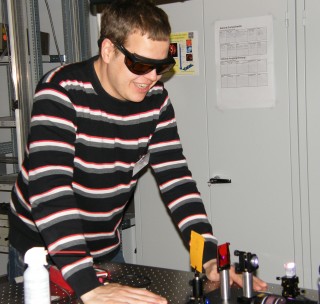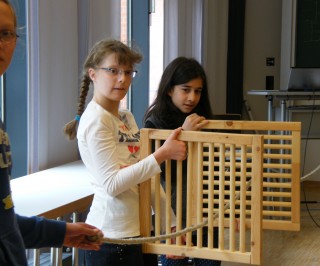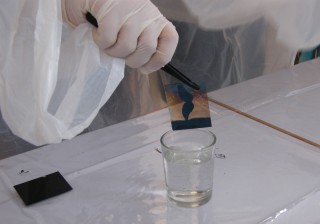24 schoolgirls from all over Hamburg took the chance provided by the Girls‘ Day on 23 April to get exciting and first of all practical insights into scientific work at the school lab Light & Schools on Campus Bahrenfeld.
This year’s program was again divided into two parts to address younger as well as elder girls. Dr. Thomas Garl, coordinator of Light & Schools, gave girls of grade 9 and 10 an understanding of the functionality of lasers. What is laser light, what is special about it, and what to use it for? These and further questions were answered in an apprehensible lecture. For the practical part the pupils built up gadgets that transported music from their mp3-players over long distances via laser. The idea is based on modern communication technology: for example data files in the internet are transported via so called optical fiber cables with the help of light.

Dr. Thomas Garl is adjusting the laser. Credit: CUI
After lunch the group attended a guided tour through the laboratory. The topic explained by postdoc Dr. Juliette Simonet in her lab was “Colder than cold: Laser cooling and the Bose-Einstein condensation.” Atoms can be cooled down to very low temperatures by laser light. The characteristics and behavior of the atoms change at a certain temperature range.
The younger girls of grade 5 and 6 got to know the liquid crystal display (LCD) together with Light & Schools-coordinator Dortje Schirok. The girls aged between ten and twelve years listened curiously to the explanations of such a display and its technical construction. “The light wave can only pass the grid if it resonates parallel to the grid,” Schirok explained.

With the help of a rope and a wooden grid the girls lerned how light passes a grid. Credit: CUI

The first display is drowned cautiously in acid. Credit: CUI
The girls could then transfer the theory into a practical demonstration with the help of an oscillating rope and a wooden grid. Afterwards they constructed their own display with personal motives that ranged from hockey sticks and basket balls to moustaches on glass sheets using edding markers, hydrochlorid acid, aceton and liquid crystals. “Do not forget to draw the electronic conductors,” Schirok reminded the group. Yet in the mean time she was happy about the good knowledge of physics the girls already had.The group was supported by Rosmarie Wirth who studies physics and assists the school lab regularly.

